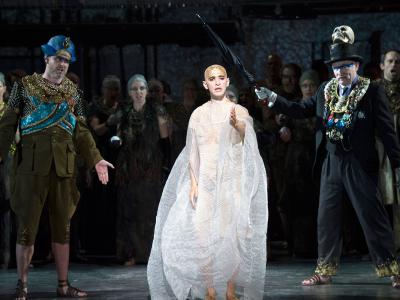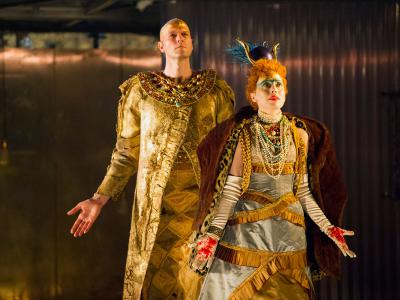Explore Akhnaten: The Context
Note on the spelling: the Pharaoh is usually written with an e ‘Akhenaten’; Philip Glass entitled his opera ‘Akhnaten’; this resource includes both spellings.
Akhenaten was an Egyptian Pharaoh of the Eighteenth Dynasty. The dates of his life are estimated as 1351-1334 BC. When his father Amenhotep III died, he inherited the double crown of Upper and Lower Egypt and ruled for 17 years with his principal wife, Nefertiti.
He is often referred to as the ‘heretic’ or ‘rebel’ pharaoh because of the great religious reforms he attempted to introduce during his reign. He declared a new religion based upon worship of a single god, the sun god, Aten, which he imposed on his people, suppressing the worship of other deities. His new god was universal and supreme. By terming himself ‘son of Aten’, Akhenaten associated himself with this all powerful God. His radical ideas were not well received by the people of Egypt and after his death, his temples were destroyed and his name was erased from monuments in an attempt to obliterate all trace of him. This was significant as Egyptian beliefs concerning the afterlife placed an emphasis on speaking the name of the deceased; rebirth in the afterlife was not possible if a person’s name was not honoured.
Late 19th and early 20th century archaeological excavations in the Valley of the Kings triggered a resurgence of interest in his story – though the full story of his life and reign remains unknown. Akhenaten’s new religion saw the sun god Aten replace the entire pantheon of Egyptian gods and goddesses. Before Akhenaten, Aten merely represented the light that emanated from the sun disc; typically represented by hands radiating from the sun and giving out the ankh sign. Akhenaten and Nefertiti became the high priests and sole mediators of Aten. This resulted in the royal couple having absolute power, undermining the power of the temple priests.
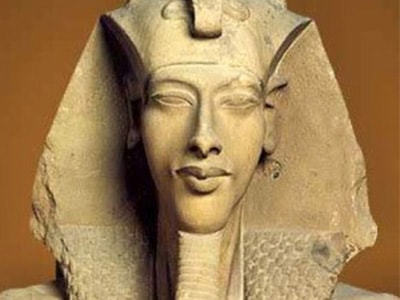
Karnak statue of Akhenaten (Cairo Museum)
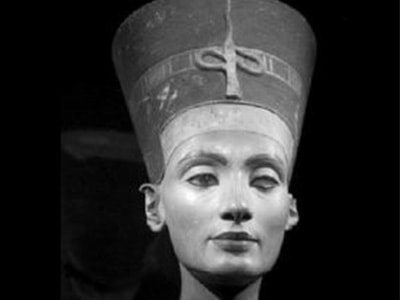
Bust of Nefertiti (Ägyptisches Museum, Berlin)
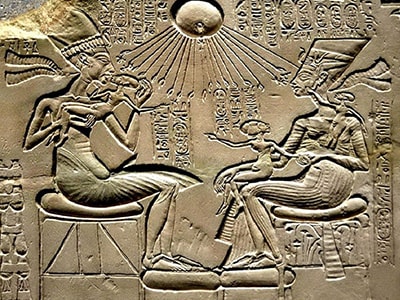
Akhenaten, Nefertiti and daughters under the sun god Aten (Ägyptisches Museum, Berlin)
Amarna
As part of Akhenaten’s reforms, a new capital city was built at Tell el-Amarna. Everything from the placement of the road and temples was for the veneration of the sun god, Aten. Akhenaten built the city on virgin territory in the desert between Thebes and Memphis. To the east of the city, the sun rises between a break in the rising cliffs. The sunrise could be ‘read’ as the hieroglyph ‘Horizon-of-the-Aten’ (Akhet-aten). It was for this reason that Akhenaten chose the spot as his city’s location.
Shortly after Akhenaten’s death, the court returned to Thebes, and the city was abandoned. Over time, subsequent rulers such as Horemheb (r.1312/1306-1292 BC) dismantled Amarna’s monuments. These actions were deliberate attempts by Akhenaten’s predecessors to erase his memory from official record.
The period of Akhenaten’s rule is called the Amarna period.
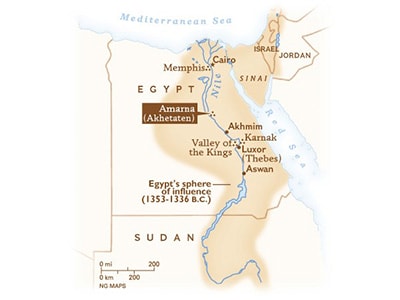
Map of Amarna (UCL Petrie Museum)
Flinders Petrie and the excavation of Amarna
Sir William Matthew Flinders Petrie (3 June 1853 – 28 July 1942), commonly known as Flinders Petrie, was an English archaeologist. He excavated dozens of major sites in the course of his career, including Amarna. Petrie was a pioneer of systematic methodology in archaeology and the preservation of artefacts.
Petrie was the first Professor of Egyptian Archaeology and Philology at University College London (UCL). In 1913, Petrie sold his large collection of Egyptian antiquities to UCL, which are now housed in the Petrie Museum of Egyptian Archaeology. The museum has a collection of more than 80,000 objects. Petrie stressed in his reports the decorative arts he excavated at Amarna. He admired the ‘new’ and ‘naturalistic’ style that differed from the traditional and conventional style of previous generations. Petrie excavated a large quantity of glass at the site, as well as evidence of kilns, showing the city was a centre for large-scale glass production.
After Petrie, various archaeological teams excavated Amarna. In the 1920s and 30s, the Egypt Exploration Society funded several expeditions, focusing on the retrieval of religious and royal structures and ‘museum-quality’ objects. During this period, The Illustrated London News published extensively on the excavations, helping to create a glamorous and fetishised image of Amarna. The city became an idyllic garden suburb with aesthetically pleasing houses and good sanitation. Akhenaten and his ‘dream city’ were an ancient precursor of modern progress. In 1977, Barry Kemp of the University of Cambridge took over directorship of excavations at Amarna. His excavation is still ongoing.
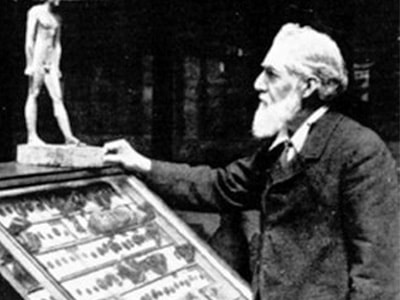
Flinders Petrie at the Petrie Museum (UCL)
Akhenaten’s legacy
Though attempts were made to obliterate Akhenaten from the history of ancient Egypt, he has inspired artists, writers, composers and groups of people who identify with him for a variety of reasons. There has been much speculation about his motivations and his reign, which have fed creative re-imaginings of this infamous pharaoh and his court. He has been considered a nature poet, an iconoclast, fundamentalist, artist and messianic philosopher. From a modern perspective, he is regarded as the first monotheist.
The British Museum collection includes stelae from the Amarna period, and two busts of Akhenaten’s father, the Pharaoh Amenhotep III, that flank the entrance to the Egyptian sculpture gallery. The gallery contains a number of statues of other pharaohs and ancient Egyptian deities, monumental pieces of stone architecture and the Rosetta Stone with its three inscribed scripts which led to the decipherment of hieroglyphs – Egypt’s ancient form of pictographic writing.


